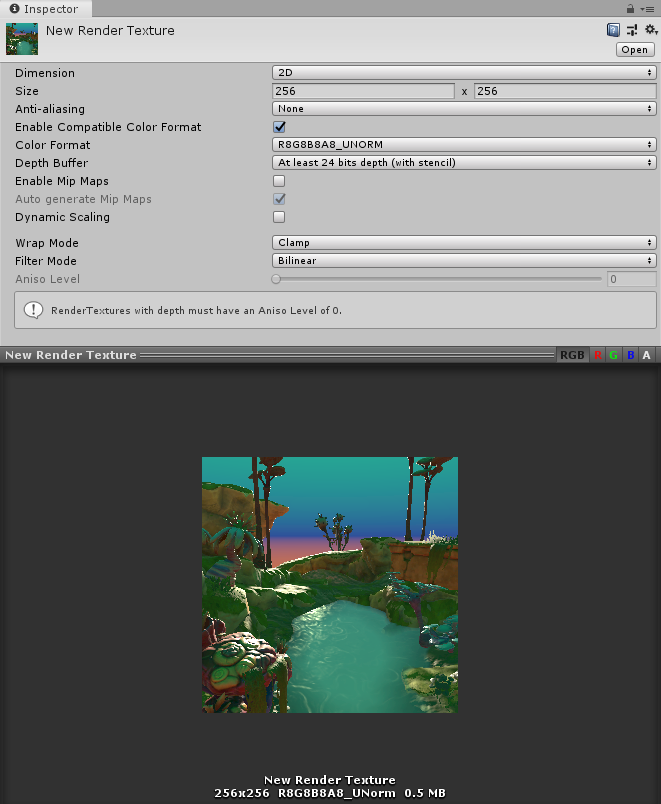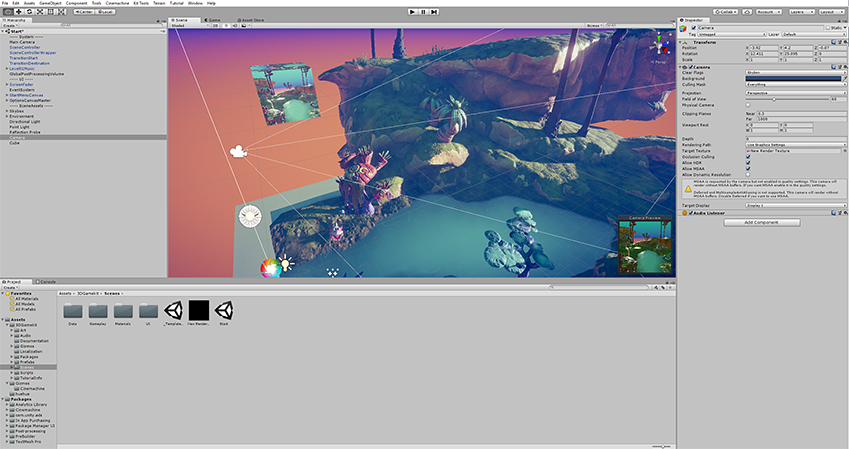Render Texture
A Render Texture is a type of Texture that Unity creates and updates at run time. To use a Render Texture, create a new Render Texture using Assets > Create > Render Texture and assign it to Target Texture in your Camera component. Then you can use the Render Texture in a Material just like a regular Texture.
Propiedades
The Render Texture inspector is similar to the Texture Inspector.

El Render Texture inspector muestra el contenido actual de la Render Texture en tiempo real y puede ser una herramienta de depuracion para efectps que utilizan render textures.
| Propiedad: | Función: | |
|---|---|---|
| Dimension | The dimensionality (type) of the render texture. | |
| 2D | The render texture is two-dimensional. | |
| Cube | The render texture is a cube map. | |
| 3D | The render texture is three-dimensional. | |
| Size | The size of the render texture in pixels. You can only enter power-of-two values, such as 128 and 256. | |
| Anti-Aliasing | The number of anti-aliasing samples. You can select None, 2 samples, 4 samples, or 8 samples. If you select None, Unity does not apply anti-aliasing. | |
| Enable Compatible Color Format | Enable this checkbox to make Unity apply a compatible format to the render texture if the defined Color Format is not supported by the platform. | |
| Color Format | El formato de color de la render texture. | |
| Depth Buffer | The format of the depth buffer. You can select No depth buffer, At least 16 bits depth (no stencil), or At least 24 bits depth (with stencil). The stencil buffer is a general purpose buffer that allows you to store an additional unsigned 8-bit integer (0–255) for each pixel drawn to the screen. | |
| Enable Mip Maps | Check this box to make the render texture generate mipmaps. | |
| Auto generate Mip Maps | Check this box to automatically fill the generated mipmaps with relevant data. If you don’t enable this, you’ll have to use the GenerateMips function to fill those mipmaps manually. Alternatively, choose which mip to render into when you call the various SetRenderTarget functions. For more information about the SetRenderTarget functions, see Graphics.SetRenderTarget and Rendering.CommandBuffer.SetRenderTarget. |
|
| Dynamic Scaling | Check this box to let dynamic resolution scaling resize the render texture. If you don’t enable this, the render texture maintains the same size regardless of the Dynamic Resolution setting. | |
| Wrap Mode | Controls how the texture is wrapped: | |
| Repeat | Tiles the texture to create a repeating pattern. | |
| Clamp | Stretches the edges of the texture. This is useful for preventing wrapping artifacts when you map an image onto an object and you don’t want the texture to tile. | |
| Mirror | Tiles the texture to create a repeating pattern that mirrors the texture at every integer boundary. | |
| Mirror Once | Mirrors the texture once, and then falls back to clamping. | |
| Per-axis | Lets you set different wrap modes for the U axis and the V axis. The available options are also Repeat, Clamp, Mirror and Mirror Once. For example, when you use latitude-longitude environment maps for reflection probes, it is useful to have Clamp on the vertical coordinate (V axis), but Repeat on the horizontal coordinate (U axis). | |
| Filter Mode | Controls how the sampling of the texture uses nearby pixels. The options are: | |
| Point | Uses the nearest pixel. This makes the texture appear pixelated. | |
| Bilinear | Uses a weighted average of the four nearest texels. This makes the texture appear blurry when you magnify it. | |
| Trilinear | Uses a weighted average of the two nearest mips, which are bilinearly filtered. This creates a soft transition between mips, at the cost of a slightly more blurry appearance. | |
| Aniso Level | Anisotropic filtering level of the texture. This increases texture quality when you view the texture at a steep angle. Good for floor, ground, or road textures. | |
Ejemplo
To create a live arena camera in your game:
Cree un nuevo asset Render Texture con Assets >Create >Render Texture.
Cree una nueva Cámara utilizando GameObject > Camera.
Assigne el Render Texture a la Target Texture de la nueva Camara,
Create a new 3D cube using GameObject > 3D Object > Cube.
Drag the Render Texture onto the cube to create a Material that uses the render texture.
Enter Play Mode, and observe that the cube’s texture is updated in real-time based on the new Camera’s output.

2019–04–11 Page amended
Render Texture inspector changed in Unity 2017.2
Ability to apply any GPU format to Render Textures added in Unity 2019.1